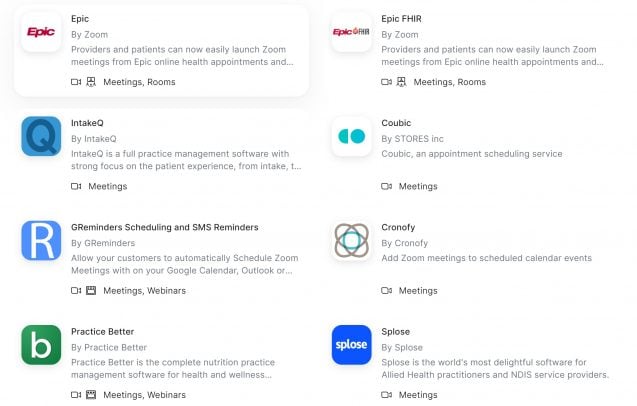The American Health Association notes that roughly 25% of patients used telehealth in 2022, adding that this far exceeds the mere five percent who did so before the Coronavirus Pandemic.
And according to Eyal Zimlichman, MD, this is due to a lack of user-friendliness and a few other factors. “The usability wasn’t there and, culturally, patients and physicians who weren’t fully ready to move to virtual care were happy to return to in-person visits.”
Zimlichman serves as Chief Innovation and Transformation Officer at Sheba Medical Center, the biggest hospital in Israel. Zimlichman previously served as an adviser to the U.S. Department of Health and Human Services Office of the National Coordinator for Health Information Technology.
That notion of a lack of user-friendliness now appears to have shifted as solutions grow evermore sophisticated, even more feature rich, and simpler to use, with Zoom and Oracle hoping to display as much with an updated partnership that has roots, going back (as far as) two years ago.
Regarding adoption, Dr. Zimlichman believes that we could see a slow rise from 20% to 25%, as we are currently seeing. He added; this may increase upwards of 50% to the 70% mark again, numbers we saw regarding telehealth adoption toward the beginning of the Pandemic.
Two Years and Counting
In 2021 Zoom chose Oracle as its cloud infrastructure provider for its core online meeting services – the duo has renewed those vows: so to speak. With Oracle technology at the backbone of Zoom’s millions of meetings, the video conferencing giant relies on the cloud conglomerate for performance, scalability, reliability, and cloud security.
The updated partnership comes after two years of the Pademic-dictating what folks can/can’t do and where they can/can’t go. For millions of immunocompromised Americans, those without reliable transportation, or people who live far from their physician – such a solution could prove consequential.
And many of these said solutions appear to have proven more than beneficial, as the American Health Association notes on its website: “During the COVID-19 Pandemic, telehealth emerged as a vital way to maintain patient access to high-quality care.”
A Dream Team of Sorts
So what does the updated partnership enable patients to do with the newfound telehealth solution? Patients can start a video visit seamlessly with the click of a button. Patients can also streamline updates to their electronic health records (EHRs): as clinicians can access tools that let them update patient records from visits. Not to forget, there are over 100 healthcare-related integrations and APIs available.

This: according to Zoom, can save valuable time that healthcare workers can give back to enhancing patient care. And Stephanie Trunzo, Senior Vice President and General Manager of Oracle Health, said it is all about reducing the administrative burden felt by healthcare practitioners, from nurses to doctors, and expanding overall access to care.
With Zoom and Oracle having such a global reach, it only makes sense that the duo have paired to expand their collective reach – this time for healthcare, as they are ubiquitous – with millions of daily active users.
Nine of the top ten hospitals ranked by U.S. News choose Zoom, with seven of the top ten global pharmaceutical companies also selecting Zoom. And eight of the ten largest U.S. health systems also choose Zoom to deliver various hybrid healthcare services.
Enabling everything from clinical trial assessments to virtual physical therapy to real-time stroke consultations, the full-HD telehealth solution paired with any number of ‘smart’ room solutions fosters a real-life-like visit with a physician.
Regarding clinical trials, there is an opportunity to go beyond patient care, as participating in potentially lifesaving treatment, research, and development becomes instantly accessible to more individuals.
Of course, there are a lot of considerations given the availability of such a solution: but the duo has ensured the offering is up to code in protecting patient data and safety. As such: Zoom and OCI support HIPAA, PIPEDA/PHIPA, GDPR, Mars-E, and compliance with various other forms of regulations.
Telehealth Solutions and Accurate Diagnoses
Something that seemed imperative to tackle when covering such a topic was: do telehealth solutions enable doctors to give accurate diagnoses? The answer: at least, according to one Mayo Clinic study of 2,400 patients fund, the answer to that query is a resounding “yes.”It found that telehealth diagnoses matched that of in-person diagnoses nearly 90% of the time.
Telehealth, More Sophisticated then Ever-Before
For years Vonage, Cisco, Twilio, Dialpad, and other providers have built various tools to support the patient experience. That means virtual waiting rooms and APIs that support robotic arms and even integrate their solutions with ‘smart’ room solutions like cameras, virtual and augmented reality, etc.
While not entirely novel, these solitons have come up with some relatively novel concepts and ways to implement said technology for patient/physician experience betterment. Take Cisco, for instance. Last year I attended an in-person press/analyst briefing in Silicon Valley.
They showcased how doctors used their technology, along with a series of cameras and sensors to do things like: diagnose patients from afar leveraging augmented/virtual reality. There was a lot to unpack regarding this experience, and I wrote about it in a series of posts on GetVoIP News.
I watched a demo of this happen, and the experience seemed seamless for both parties involved. In a nutshell, what is possible today: using said telehealth solutions are far ahead of what some of the earliest developers of this technology once imagined.
With the assistance of augmented and virtual reality, what is possible today is something I believe we have not even begun to unearth. And the possibilities are likely near endless. Zoom and Oracle seem to have ‘fingered the pulse’ tapping into that notion and hope its solution will become the future of telemedicine/health. For that, only time will tell.



